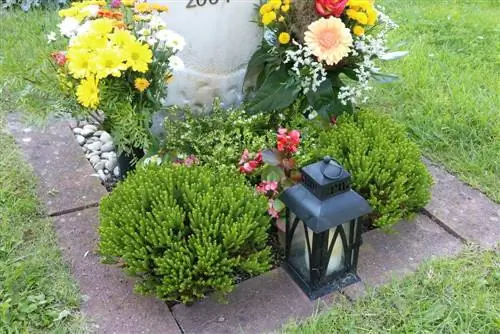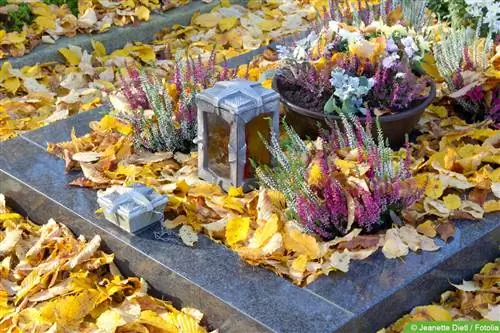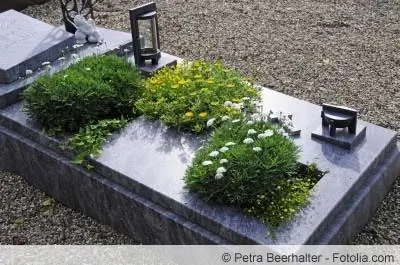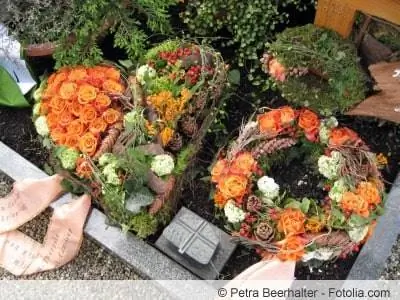- Author admin [email protected].
- Public 2023-12-17 03:39.
- Last modified 2025-06-01 06:48.
Everyone wants to make the final resting place of their loved ones beautiful. It is intended to express how much you still think about people. How valuable this person was to us. It's not just the design of the grave, especially the design of the flowers and plants, that is important, but also the earth. There are so many different types of soil that you don't know what is right. Which soil is good and important for plants?
Why should you use grave soil for your final resting place? Can't you just use normal soil? A lot of people ask themselves this question. The question is answered very simply. Grave soil has a completely different structure than normal soil. Grave soil is much darker than normal soil. High-quality peat guarantees good plant growth and improves the humus content. Covering the grave prevents the soil from drying out and prevents weeds. The grave cover looks even and gives the grave an aesthetic look. The flowers and plants come into their own even more. Of course, grave soil contains all the important nutrients for your plants. The substance of the soil prevents the irrigation water from running away.
Graberden - floor care
A good grave soil is primarily characterized by its good water storage capacity. In addition, the main focus is on air permeability. Last but not least, high-quality grave soil usually has an optimal mix of nutrients so that plant growth and resistance can be optimally supported.
After a certain time, the soil usually sags due to physical circumstances, so that it is necessary to fill up grave soil. This can easily be mixed with classic potting soil to which a little lime and other ingredients have been added. The fact is that grave soil is not only intended to supply a certain type of plant with relevant nutrients in the long term, but also different flowering plants, shrubs and trees are usually used. Of course, “normal” grave soil is not “able” to guarantee a comprehensive supply of nutrients, which means that additional fertilization must be carried out in certain areas of the grave area (based on the individual needs of the plants).
“Basic” work on the grave earth
- hill up the earth from time to time (if the soil sags)
- regular raking of the earth's surface
- If necessary, planting with particularly long-rooted plants (stability)
- regular watering
- fertilize only from time to time (where special nutrient requirements are required)
In general, the earth can “settle” from time to time or grooves and similar “structures” form. This sometimes happens, for example, after excessive rain. Anyone who ensures that the surface of the grave is loosened from the start, first with a coarse rake and then with a fine-toothed rake, usually ensures that the even, air-permeable texture is maintained despite adverse circumstances. Filling with humus soil can also be beneficial to improve the quality of the soil.
(No) comparison to “classic” soil
Too many nutrients are usually not preserved in grave soil. It is therefore available in stores at a correspondingly low price. The reason for the comparatively low nutrient content of grave soil is clear: plants and therefore also weeds grow particularly well in nutrient-rich soil. However, graves are not always maintained continuously, so care must be taken from the outset to ensure that there is no excessive weed growth. In addition, most plants (except trees or bushes) are only on the grave for a limited period of time in order to create the most attractive and varied image possible on site. The fact is that cheap grave soil is extremely unsuitable for use in normal gardens.
Stones and plants
In any case, it is important to rake and water grave soil regularly. If necessary, fertilizer can be added, although here too, care should be taken not to “over-care” the areas. Experienced gardeners know that the formation of trickles on graves can be reduced by carefully placing decorative stones or by cleverly placing grass plants.
Black Earth
Traditionally, very dark, even deep black earth is chosen for graves. The achromatic color black symbolizes death and mourning in Western culture. In addition, colored flowers and green plants stand out from the black background in a more contrasting and therefore very decorative way. The soil enriched with peat gets its black color from the addition of manganese and soot. The rich black color created in this way fades over time due to the weather, so it has to be reapplied again and again. In addition, this soil must be applied with gloves, as the manganese blackens the hands in the long term.

However, there are now grave soils that, thanks to a patented manufacturing process, no longer stain and permanently retain their black color. The choice of this peat-free, or at least heavily peat-reduced, grave soil is advantageous in two respects. The lower the peat content, the lower the risk of soil acidification. This involves more plant species thriving on the soil. These grave soils are also more environmentally friendly. They relieve pressure on our endangered, natural peat reserves.
Advantageous properties
Like all soils, grave soil is available in different qualities. It can be very fine and well structured, with a spreadable consistency but also lumpy and interspersed with pieces of wood or fibers.
Basically, the ideal grave soil is always denser and heavier than potting soil. This has the advantage that it retains moisture significantly better and therefore longer. This means that a grave with this special soil needs to be watered less often and saves you having to go to the cemetery almost every day in dry times.
The finer the structure, the more beneficial it is for the plant's root growth. Of course, other factors also play a role in the composition. The advantage of good grave soil is a balanced microbiological admixture of photosynthetic microorganisms, especially many organic nutrients and trace elements. The grave soil acts as an ideal long-term multi-nutrient fertilizer and ensures that the grave plants remain he althy.
The declaration of chemical properties may vary slightly per manufacturer, but, with slight differences, looks something like this:
- pH value (CaCl2) 5, 3
- Salinity (KCI) 2.6 g/l
- Available nutrients (soluble):
- Nitrogen (CaCl2) 130 mg/l N
- Phosphate (CAL) 100 mg/l P2O5
- Potassium oxide (CAL) 220 mg/l K2O
- Magnesium (CaCl2) 90 mg/l Mg
Alternatives
You keep hearing the question, probably asked for cost reasons: “Isn’t it enough to use normal soil?” The answer is simply: “No”. Plain soil is much more maintenance-intensive and less decorative. For a long time now - as with mourning clothing, which is no longer subject to the dictates of being completely black - there has been a trend towards “lighter” earthy material.
Primarily these are mulches made from softwood bark, such as bark mulch, decorative pine bark and the pleasantly scented pine bark, which largely inhibit weed growth, form a loose, air-permeable subsoil and make a visually well-groomed impression. They are available in different degrees of fineness, although the finer versions are preferred for graves. The most common grits are:
- 00-07 mm extra fine
- 00-10/16 mm very fine
- 07-15 mm fine
- 10-20/25 mm medium
- 10-40 mm coarse
The biologically valuable bark humus is also obtained from the fermented bark of softwoods. It contains all the important nutrients, defuses any soil acidification and is an excellent water reservoir. As a permanent decorative eye-catcher, volcanic pumice (light color) or volcanic lava (brownish) is often applied as a top layer.






